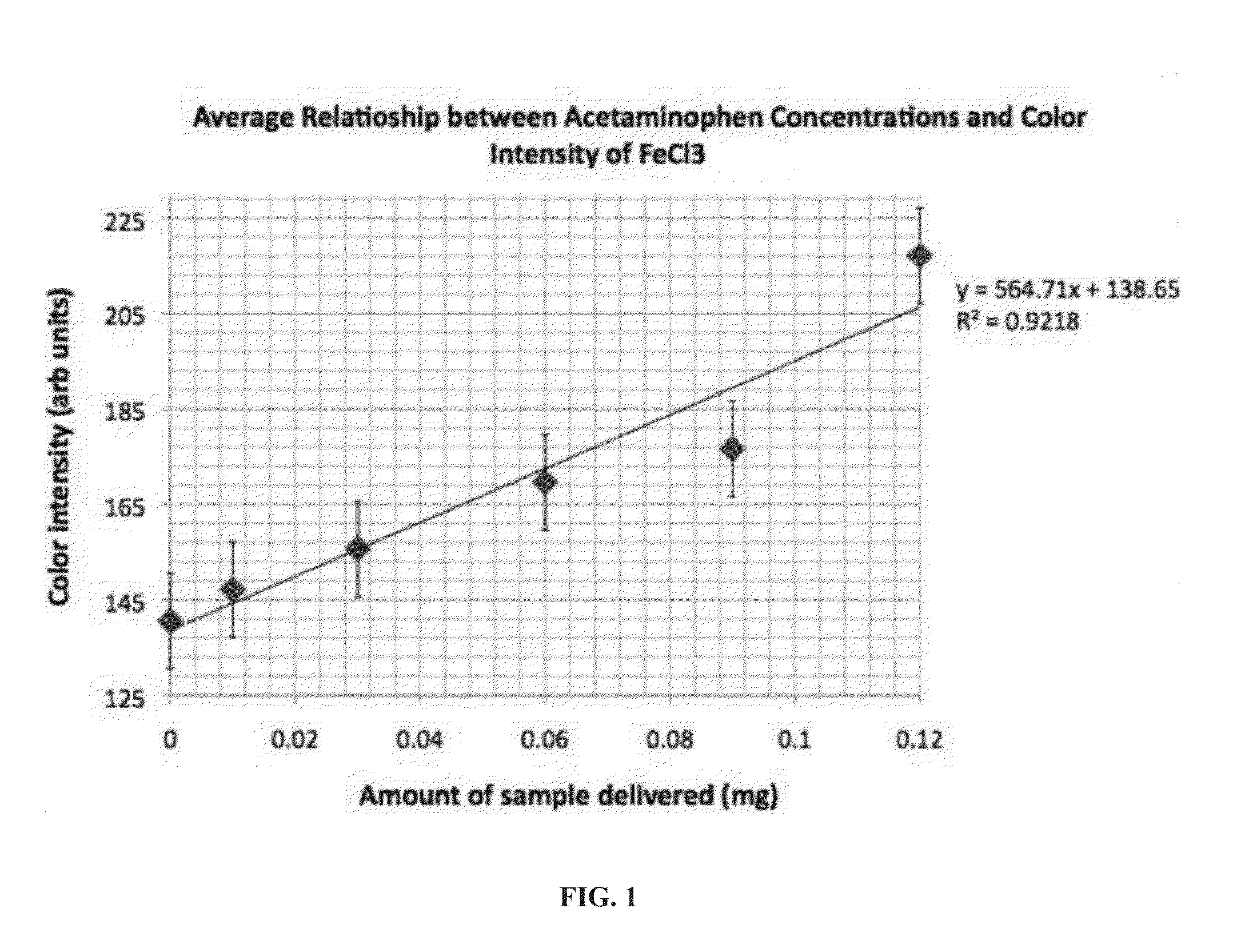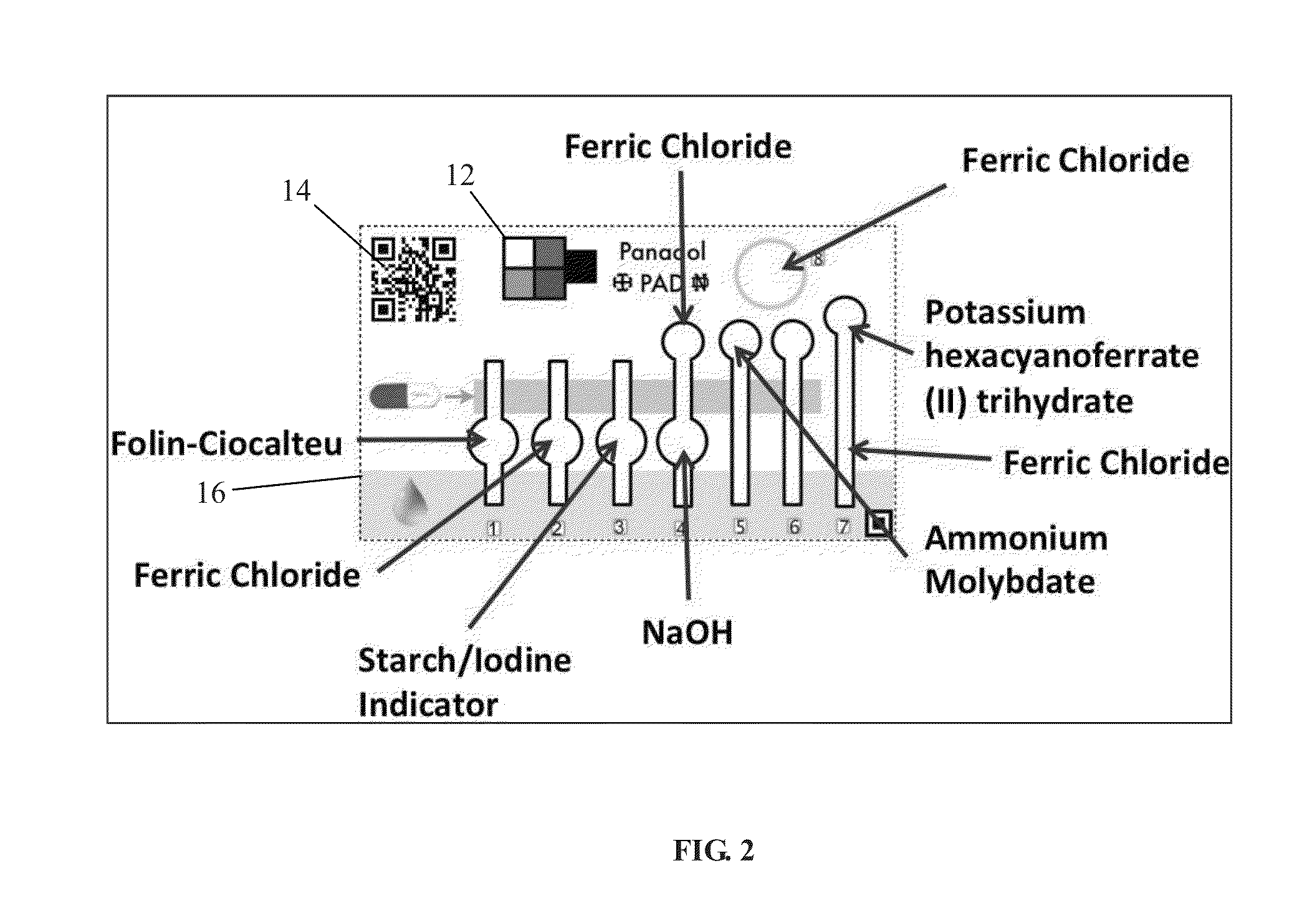Analytical devices for detection of low-quality pharmaceuticals
- Summary
- Abstract
- Description
- Claims
- Application Information
AI Technical Summary
Benefits of technology
Problems solved by technology
Method used
Image
Examples
example 1
Paper Analytical Device for Analyzing Acetaminophen
[0065]Previously attempts were made to identify low quality acetaminophen tablets utilizing near-infrared spectroscopy, which is an expensive, time-consuming process. These products are known under the trade name Panadol or TYLENOL®.
[0066]The acetaminophen PAD contains tests that are adapted to the analysis of acetaminophen tablets. In particular, it is imperative to identify acetaminophen, the active ingredient. The structure of acetaminophen is shown below:
Acetaminophen Structure
[0067]FIG. 2 shows one embodiment of an acetaminophen PAD. The acetaminophen PAD comprises a color calibration zone, an identification zone, reaction areas (lanes 1-6, circle 8) as well as a timer region (lane 7). Table 1 herein shows the location of the embedded reagents, the amounts embedded, the chemicals to be detected, the color change expected with a positive reaction, and the minimum amount of the chemical or active agent necessary in order to resul...
example 2
Paper Analytical Device for Analyzing TAMIFLU®
[0080]One of the most prevalent anti-viral medications is TAMIFLU® (TAMIFLU® is a registered trademark of Hoffmann-LaRoche Inc.), a neuraminidase inhibitor that fights both influenza types A and B. Tamiflu® contains the active ingredient oseltamivir phosphate. The six to eight months synthesis time of oseltamivir phosphate, in conjunction with the increasing global demand for Tamiflu®, has led to a Tamiflu® shortage in recent years. This, in turn, has made the international market particularly vulnerable to low quality Tamiflu® products, which, unlike other low quality pharmaceutical products, always lack the active ingredient completely and thus, is never underdosed. Tragically, untreated influenza leaves infected individuals extremely susceptible to secondary infections that, in turn, can lead to death. The structure of oseltamivir phosphate is shown below:
Oseltamivir Phosphate Structure
[0081]FIG. 3 shows one embodiment of a Tamiflu® P...
example 3
Artemisinin Combination Therapies (ACT) PAD
[0093]Malaria is a life-threatening disease that plagues the developing world, especially the tropical regions of Africa and Asia. It is estimated that half the world's population is at risk for contracting malaria and that malaria is one of deadliest infectious diseases worldwide. This statistic is particularly devastating since malaria is a preventable and curable illness. One factor that contributes to the deadliness of this treatable illness is the prevalence of low quality drugs.
[0094]Artemisinin-derivative compounds such as artesunate (AS) and artemether (AM) are the most effective pharmaceuticals for treatment of malaria. They are best administered in combination with another antimalarial such as amodiaquine or lumefantrine. These treatments are known as artemisinin combination therapies (ACTs); they are the most potent and highly recommended treatment for Plasmodium falciparum malaria infection. Unlike chloroquine, the malaria paras...
PUM
 Login to View More
Login to View More Abstract
Description
Claims
Application Information
 Login to View More
Login to View More - R&D
- Intellectual Property
- Life Sciences
- Materials
- Tech Scout
- Unparalleled Data Quality
- Higher Quality Content
- 60% Fewer Hallucinations
Browse by: Latest US Patents, China's latest patents, Technical Efficacy Thesaurus, Application Domain, Technology Topic, Popular Technical Reports.
© 2025 PatSnap. All rights reserved.Legal|Privacy policy|Modern Slavery Act Transparency Statement|Sitemap|About US| Contact US: help@patsnap.com



